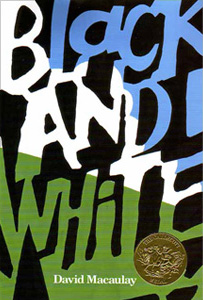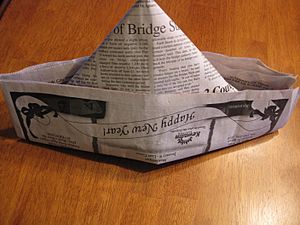Black and White (picture book) facts for kids
 |
|
| Author | David Macaulay |
|---|---|
| Illustrator | David Macaulay |
| Country | United States |
| Genre | Children's picture book |
| Publisher | Houghton Mifflin |
|
Publication date
|
March 1990 |
| ISBN | 978-0-395-52151-9 |
| OCLC | 246622739 |
| LC Class | PZ7.M1197 Bl 1990 |
Black and White is a unique picture book from 1990 by David Macaulay. It was published by Houghton Mifflin. When it first came out, people had different opinions about it. However, it won the famous Caldecott Medal in 1991 for its amazing illustrations.
This book tells four different stories at the same time. These stories are all connected in interesting ways. Each story also looks different, with its own special drawing style. The four stories are: "Seeing Things," about a boy on a train trip alone; "Problem Parents," about two kids whose parents act strangely one night; "A Waiting Game," about people waiting for a train; and "Udder Chaos," about cows that escape and then return to their field.
David Macaulay got the idea for a book about journeys in the 1980s. He put together several drawings he already had to create these four stories. Because of its special way of telling stories (called metafiction, where a story is about storytelling itself), Black and White is a great example of a modern picture book. The book is made to be understood in many ways. It encourages readers to think and connect the dots themselves. The words and pictures in the book work together, but sometimes they also show different things. Black and White is known for helping to change what picture books could be. It has inspired many other picture books too.
Contents
How the Book Was Made
David Macaulay started drawing ideas for Black and White in the 1980s. He was very interested in the idea of journeys. He especially liked the idea that turning a page in a book could feel like a journey itself.
Eventually, Macaulay decided to combine four different stories from his sketchbooks into one book. He wanted each story to look very different. He said, "I did everything I could to visually separate each fragment." This included using different art tools and characters for each story. The book was released in March 1990 by Houghton Mifflin.
What Happens in the Stories
Each two-page spread in Black and White shows parts of the four stories. They are placed in different corners of the pages.
Seeing Things
This story is in the top left part of the pages. It's about a boy taking an overnight train trip by himself. He is going to meet his parents. At one point, the train stops. An "old woman" briefly joins him. But the pictures make you wonder if it's actually the robber from "Udder Chaos."
The boy looks out the window but can't tell why the train stopped. He laughs when the driver tries to chase away what look like big rocks. To his surprise, the "rocks" start to move off the tracks! Later, the boy falls asleep. He wakes up when the train stops again and hears singing. He thinks he sees snow outside and opens the window. But when he tries to catch it, he realizes it's torn-up newspaper. The boy then sees "strange creatures" near the train who are making the singing and torn paper. When the train starts moving again, he falls back asleep. He wakes up at the train station and is reunited with his parents.
Problem Parents
This story is in the bottom left part of the pages. It's told by a sister, who is with her brother. They know their parents' daily routines very well. For example, their parents always leave for work at 7 a.m. and come home at 7 p.m.
But one night, the kids and their dog notice something different. Their parents come home wearing costumes made of newspaper and singing "She'll Be Coming 'Round the Mountain." The parents then find more newspapers at home. They ignore normal conversation and dress the children in newspaper costumes too. The brother joins the fun faster than his sister. She tries to get her parents to act normal again, but it doesn't work. The narrator is shocked when her brother suggests they go out to dinner dressed like that! She manages to convince everyone to leave the costumes at home. In the end, the narrator admits the experience was fun. But she finds her parents' silly actions "exhausting" when they ask about her homework as she goes to bed.
A Waiting Game
This story is in the top right part of the pages. The only words are announcements from a loudspeaker. Many passengers are waiting for their train at a station. They are all reading newspapers. The train is delayed.
Eventually, the passengers finish their newspapers and get bored. One passenger makes a triangle hat out of her newspaper, and everyone claps. Soon, other passengers start making newspaper shirts, decorations, and confetti. When the train finally arrives, they throw the torn newspaper into the air. After the train leaves with the passengers, only a robber and the station master are left. The station master is cleaning up the newspaper mess.
Udder Chaos
This fourth story is in the bottom right part of the pages. The words describe what happens if Holstein cows escape their field. But the pictures show a robber, dressed in black and white stripes and a black mask. First, he hides among the cows. Then he hides among a choir that the cows pass by. After that, he hides among the cows again when they stop a train. In the end, the robber has disappeared. The cows return home so they can be milked.
Art and Storytelling
Black and White is seen as a great example of a modern picture book. This is partly because it plays with how stories are told. David Macaulay himself said, "the subject of this book is the book." He meant that the book is designed to be looked at as a whole, with its surface "read all over." It's a book about how things connect: pictures connect, and words connect with pictures.
Each of the four stories has its own unique look and drawing style:
- "Seeing Things" was drawn with watercolors.
- "Problem Parents" used pen and ink, with words in speech bubbles.
- "A Waiting Game" used colored ink.
- "Udder Chaos" used colored ink, but without the usual outlines.
The way the stories overlap is never fully explained. It's up to you, the reader, to figure out the connections. The book even has a warning on the title page to "carefully" look at the different stories. Even the way the text is written encourages you to be an active part of the story. You figure out how many stories there are and how they connect mostly by looking closely at the pictures. You can read the stories in any order, or even jump around. Macaulay said, "it isn't necessary to think in straight lines to make sense." The words are also subtly funny, using irony (saying one thing but meaning another).
The pictures add important parts to the story. For example, a mask is drawn on almost every page, but the word "mask" is never in the text. This makes the book fun for both younger kids and older kids or teens.
Macaulay enjoys playing with how the words and pictures work together. Sometimes they match, like at the start of "Problem Parents." But other times, they don't quite agree. In "Seeing Things," the text says an "old woman" is on the train, but the pictures suggest it's the robber. Sometimes the text can even be misleading. In "Udder Chaos," the text is about cows, but the pictures focus on a robber. Some people even think the robber is just something the boy from "Seeing Things" imagines.
The pictures also connect with each other. A drawing of a cow's udder even becomes the "U" in the title "Udder Chaos." There are also visual similarities between the stories and characters. The boy in "Seeing Things" and the robber (who appears in "Seeing Things" and "Udder Chaos") both wear striped shirts. The robber's mask and the dog's face look quite similar. The dog, whose name tag says "Chris," might be a nod to author Chris Van Allsburg. His books often feature a terrier dog.
Main Ideas in the Story
Some big ideas in the story include the relationship between parents and children, and how everything in life is connected. Trains are a common theme that appears in all four stories. The two stories on the left pages (about the children) have a similar idea. Both sets of children are trying to understand strange events and want to be reunited with their parents.
The book also suggests that nothing is as simple as it seems. For example, the words "Black and White" on the cover are written in blue, white, and green. On the title page, they are red. This red color might be a clue to the old joke: "What is black and white and read all over? Newspapers!" Newspapers are very important in the story.
Black and White shows both order and chaos. This is seen in the stories, the pictures, and the book's design. The chaos in the story grows, reaching its peak when only black and white colors are used on a page. Then, order returns at the end of the stories and the book. However, the very last page shows a hand picking up the train station from "A Waiting Game" and the nose of the dog from "Problem Parents." This ending can be understood in many different ways!
What the Book Left Behind
Black and White is known for helping to change what people thought a picture book could be. It was quickly seen as an important way to connect with kids in a new, more digital world. Some people even call Black and White a "transition text" between old-style and new-style picture books.
Many children enjoy this book. However, some teachers might feel that the book's complexity is too much for younger kids. But the children who love the book often do so because it makes them think! Teachers who use the book can show how all the parts together make something greater than each part alone. It's also a great example of how working together and discussing a book can help everyone understand it better. Black and White is also seen as an inspiration for other books, like The Stinky Cheese Man and Other Fairly Stupid Tales.
| Awards | ||
|---|---|---|
| Preceded by Lon Po Po: A Red-Riding Hood Story from China |
Caldecott Medal recipient 1991 |
Succeeded by Tuesday |


